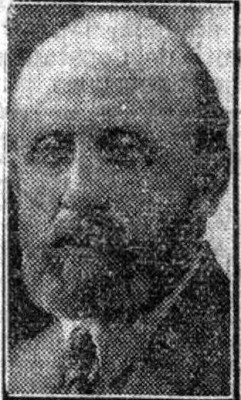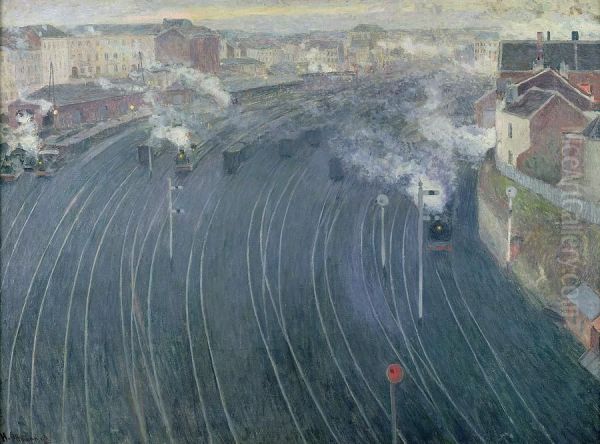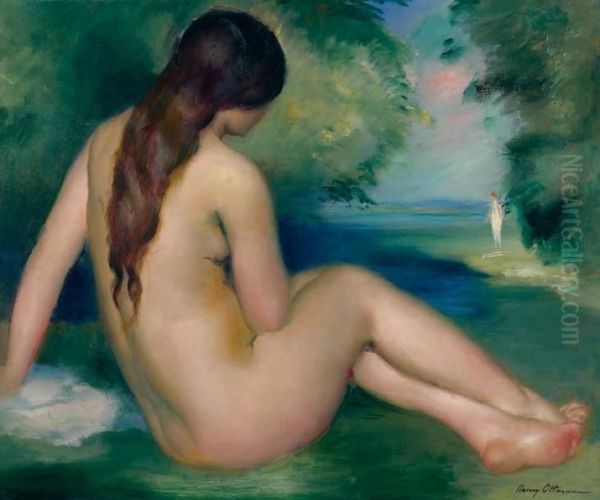
Henri Ottmann stands as a notable figure in French art history, bridging the vibrant era of Impressionism with the burgeoning movements of the early 20th century. Active from the late 19th century until his untimely death, Ottmann carved a niche for himself through his distinct approach to color, light, and modern subject matter. His works, often characterized by their lively palettes and dynamic compositions, reflect the artistic ferment of his time, placing him in dialogue with some of the most influential artists of the period.
Though recognized primarily as a French painter, Ottmann's career trajectory and artistic development reveal connections across borders and styles. He navigated the Parisian art world, exhibiting in prestigious Salons, while also drawing inspiration from key figures and movements, ultimately creating a body of work that captures both the intimacy of personal life and the energy of the modern world. His legacy persists through his paintings housed in various public collections and their continued presence in the art market.
Early Life and Artistic Beginnings
Henri Ottmann was born in 1877. While specific details about his formal artistic education remain scarce in historical records, his emergence onto the art scene suggests a dedicated period of training and development. His early artistic activities connect him to the Belgian art world, indicating a formative period possibly spent outside of France or within circles that had strong ties to Belgian artistic trends.
Sources suggest Ottmann began his journey at the "L’Effort" workshop or studio in Brussels, a hub known for fostering artistic talent. This connection points to an early immersion in an environment likely influenced by Symbolism and the burgeoning Post-Impressionist ideas circulating in Belgium at the turn of the century. His public debut is often cited as occurring around 1903 or 1904 at the Salon de la Libre Esthétique in Brussels, a significant venue known for showcasing progressive art. This early exhibition marked his entry into the professional art world.

Despite these Belgian connections, Ottmann is predominantly identified as a French artist. His subsequent career unfolded mainly within the French context, particularly in Paris, which was the undisputed center of the Western art world at the time. This dual Franco-Belgian aspect highlights the fluid nature of artistic exchange in Europe during this period.
Artistic Style: Impressionism, Fauvism, and Personal Vision
Henri Ottmann's artistic style evolved throughout his career, rooted initially in the principles of Impressionism but absorbing influences from subsequent movements, most notably Fauvism. His work is often characterized by a keen sensitivity to light and color, hallmarks of Impressionism, yet frequently pushed towards greater intensity and expressive freedom, aligning him with Post-Impressionist and Fauvist sensibilities.
Sources note his admiration for Pierre-Auguste Renoir, suggesting that Ottmann drew inspiration from Renoir's vibrant palette, sensuous brushwork, and often intimate subject matter, particularly the depiction of figures and the warmth of human scenes. This influence can be perceived in the richness and sometimes "coarse" (perhaps meaning bold or textured) application of color mentioned in relation to his work.
Furthermore, Ottmann is said to have been influenced by Paul Cézanne. This suggests an interest in structure and form beneath the surface appearances, a concern that drove Cézanne and became foundational for later modern art. This influence might be seen in Ottmann's compositions and his attempt to balance representational accuracy with pictorial construction, possibly contributing to a stylistic shift observed later in his career.
Around the time Fauvism exploded onto the Parisian scene in 1905, Ottmann was actively exhibiting. His works from this period sometimes incorporate the bold, non-naturalistic colors and simplified forms associated with the Fauves, though perhaps not with the same radical intensity as leaders like Henri Matisse or André Derain. His style seems to represent a synthesis, retaining an Impressionistic concern for atmosphere while embracing a more modern, expressive use of color.
His subject matter was diverse, encompassing genre scenes, landscapes, still lifes, and notably, depictions of modern life and the female form. He painted scenes capturing the dynamism of the city, such as railway stations, alongside more traditional subjects. Nudes and female portraits became increasingly central to his work, rendered with his characteristic blend of sensitivity and bold coloration.
Key Works and Thematic Focus

Several key works help illustrate Henri Ottmann's artistic concerns and stylistic range. Among his most frequently cited paintings is Vue de la gare du Luxembourg (View of the Luxembourg Station). This work exemplifies his interest in modern themes, capturing the steam, speed, and industrial atmosphere of the railway station in Paris. Such subjects were popular among Impressionists and Post-Impressionists seeking to depict contemporary urban life. Ottmann's treatment likely combined Impressionistic light effects with a more modern dynamism.
Another significant early work is La Robe rose (Madame Ottmann), dated 1903. This portrait, presumably of his wife, showcases his abilities in figure painting and portraiture early in his career. The title emphasizes the color of the dress, suggesting that, even in his earlier work, color was a primary vehicle for expression and composition. This painting stands as an important marker of his output during his initial years of public exhibition.
La Dame à la balcon (The Lady on the Balcony) is another notable piece, known to be housed in the Mu.ZEE (Fine Arts Museum Ostend) in Belgium. This work likely displays his skill in capturing light, perhaps the interplay between an interior space and the exterior view from the balcony, a common motif allowing artists to explore complex light conditions and compositional arrangements. It further highlights his focus on female subjects within intimate or domestic settings.
Other documented works demonstrate the breadth of his oeuvre. Paintings like Transport and Baigneuse (Bather), which appeared at auction, suggest his engagement with themes of modern movement and the classic subject of the bather, respectively. Titles like Young Man, Trees, House on the Hill, and Reclining Woman indicate his work across portraiture, landscape, and the nude. Orée du boil par brume (Edge of the woods in mist) points to his atmospheric landscape painting. Around 1914, his style reportedly simplified, focusing more intensely on the female nude.
Participation in the Parisian Art Scene and Contemporaries
Henri Ottmann was an active participant in the vibrant Parisian art world during a period of intense innovation and change. His regular exhibition activity placed him firmly within the milieu of avant-garde and established artists. His presence in major Salons was crucial for visibility and engagement with contemporary artistic currents.
From 1905 onwards, Ottmann became a regular exhibitor at the Salon des Indépendants. This artist-run, jury-free exhibition was a vital platform for progressive artists, founded by figures like Paul Signac. Exhibiting here meant Ottmann's work was shown alongside a wide spectrum of modern art, from Neo-Impressionism to the emerging Fauvist and Cubist styles. It provided exposure to new ideas and potential patrons.
He also exhibited at the Salon d'Automne, another major venue established in 1903, known for launching Fauvism in its controversial 1905 exhibition. Participation in the Salon d'Automne further solidified Ottmann's position within the contemporary art scene, allowing his work to be seen alongside that of leading figures.
The provided sources explicitly mention Ottmann's connections or exhibition alongside several prominent contemporaries. These include key figures associated with Fauvism and other modern movements:
André Derain
Henri Matisse
Édouard Vuillard (associated with the Nabis)
Henri Lebasque (known for his intimate, light-filled scenes)
His influences connect him to earlier masters:
Pierre-Auguste Renoir
Paul Cézanne
Given his participation in the Impressionist/Post-Impressionist/Fauvist milieu and the major Salons, he would have inevitably been aware of, and likely interacted with or competed alongside, many other significant artists of the era. These include foundational Impressionists like Claude Monet, Edgar Degas, and Camille Pissarro, whose legacy shaped the landscape Ottmann entered. Within the context of the Salon des Indépendants, figures like Paul Signac were influential. Among the Fauves, besides Matisse and Derain, artists like Maurice de Vlaminck and Raoul Dufy were prominent contemporaries. This network of influences, exhibitions, and associations underscores Ottmann's engagement with the dynamic art world of his time.
While the sources mention collaboration and interaction, the art world is inherently competitive. Artists like Ottmann were constantly positioning themselves, developing unique styles while responding to trends and the work of their peers. His relationship with Henri Lebasque, for instance, points to direct interaction, while Lebasque's own stylistic evolution, influenced by his time in the South of France, reflects the broader artistic explorations and rivalries of the period. Ottmann's consistent exhibition record suggests a determined effort to maintain his presence and reputation amidst this competitive environment.
Later Career, Tragic Death, and Legacy
In the years leading up to and following World War I, Henri Ottmann continued to paint and exhibit. Sources suggest that around 1914, his style underwent a degree of simplification, with an increasing focus on the female nude as a primary subject. This might reflect a consolidation of his artistic interests or a response to broader trends towards classicism or simplified forms seen in the work of various artists during and after the war.
His career, however, was cut tragically short. In 1927, Henri Ottmann died suddenly as a result of a traffic accident. This abrupt end came while he was still actively working; it is noted that he left behind an unfinished painting, a poignant symbol of a life and artistic journey interrupted mid-stream. His death at the age of 50 removed a distinct voice from the French art scene.
Despite his relatively short life, Ottmann left behind a considerable body of work that continues to be recognized. His paintings are held in several public museum collections, attesting to his historical significance. These include prominent institutions in France, such as:
Musée d'Orsay, Paris (housing art from the mid-19th to early 20th century)
Musée National d'Art Moderne, Paris (Centre Pompidou)
Musée Rolin, Autun
His work is also found in Belgian collections, reflecting his early ties:
Musée des Beaux-Arts de Namur
Mu.ZEE (Fine Arts Museum Ostend)
Furthermore, his work is noted as being in a major museum collection in Luxembourg City (likely the Villa Vauban - Musée d'Art de la Ville de Luxembourg or the National Museum of History and Art). The presence of his work in these diverse institutions ensures its accessibility to the public and secures its place in the narrative of early 20th-century European art.
Presence in the Art Market
Beyond museum collections, Henri Ottmann's work continues to circulate on the art market, indicating sustained interest from collectors. Auction records provide concrete evidence of his market presence and the value attributed to his paintings.
For example, in a 2011 auction, his painting Transport (measuring 61 x 73 cm) was sold for €2000. In the same sale, another work, Baigneuse (Bather) (60 x 73 cm), achieved a price of €2500. These figures suggest a moderate but consistent market valuation for his oil paintings from that period.
More recently, a 2021 auction saw his work Orée du boil par brume sell for €149. While this price is lower, it could reflect various factors such as the medium (potentially a work on paper or a smaller study), condition, provenance, or fluctuations in the market for artists of his standing. The continued appearance of his works at auction demonstrates that he remains a collectible artist. The estimated price range of €2000-€3000 for the painting Transport further reinforces his position within a specific tier of the early 20th-century French art market.
This market activity complements his institutional recognition, showing that Ottmann's art is valued not only for its historical and aesthetic merit within museum contexts but also holds appeal for private collectors.
Conclusion: An Enduring Contribution
Henri Ottmann emerges from the historical record as a dedicated and talented French painter whose work navigated the transition from Impressionism to early Modernism. Born in 1877 and active until his accidental death in 1927, he developed a style characterized by vibrant color, sensitivity to light, and an engagement with both modern urban themes and intimate depictions of the female form. Influenced by masters like Renoir and Cézanne, and exhibiting alongside key figures such as Rouault, Derain, Matisse, and Vuillard, Ottmann was an active participant in the dynamic Parisian art scene.
His regular presence at the Salon des Indépendants and the Salon d'Automne placed his work at the heart of contemporary artistic debates. While perhaps not as revolutionary as some of his peers, Ottmann synthesized prevailing influences into a personal vision, contributing works like Vue de la gare du Luxembourg and La Robe rose to the artistic output of the era.
His legacy is preserved through his paintings held in important museum collections across France, Belgium, and Luxembourg, and through the continued interest shown in his work on the art market. Henri Ottmann remains a significant figure for understanding the richness and diversity of French painting in the fertile period spanning the turn of the 20th century, representing a bridge between established traditions and emerging avant-garde sensibilities.